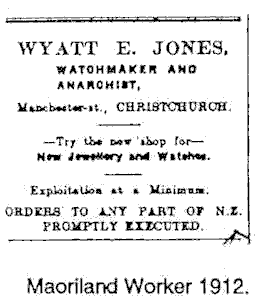By the turn of the century there were only a few hundred active socialists in Aotearoa, but with the arrival of 190 men and women who intended to form a co-operative colony, the number almost doubled. The colony was backed by William Ranstead the financial supporter of the "Clarion", a socialist weekly magazine published in England. The colony was never established and the "Clarionettes", as they were known dispersed throughout New Zealand. Nevertheless they did help to establish the first New Zealand Socialist Party.
The first branch was set up in Wellington in July 1901. The party represented most shades of socialist thought from Marxists, Fabians, parliamentary socialists, to syndicalists and anarchists, and was loosely organised. Soon after other branches were formed in Auckland and Christchurch. Tom Mann was an early organiser for the Party. Mann along with Benn Tillett, who also visited Aotearoa, had been organisers of the successful 1889 London dock strike. By 1903 the Party had established a journal called the "Commonweal", based in Wellington and edited by Robert Hogg. Wellington became the centre for a group of anti-parliamentary socialists. Hogg declared in the first issue of "Commonweal".
|
At last night's meeting of anarchists, the principal said they were there to commemorate the political murder of the men who had become known throughout the world as the Chicago martyrs. He enumerated the martyrs, and said he had personal evidence having been associated with some of their comrades, of their superior abilities as organisers of the workers and as propagators of rationalism at that time. These men had been brutally murdered because they had dared to show the wage-slaves how they were exploited by capitalists -- because they realised that organisation was necessary for the salvation of the workers, who were then practically disorganised in the United States. The capitalist class, who composed the State,- deemed it necessary to get rid of these organisers, and so they were flung into prison and some eventually murdered.
Wellington anarchists commemorate the Chicago Martyrs
(New Zealand Times, 12 November 1907) |
At first the growth of the party was slow but by 1907-08 the increase in membership was dramatic. In April 1908 the party claimed 3000 members. That same year they held their first national conference. The first objective was; The establishment in New Zealand of a co-operative commonwealth founded on the socialisation of land and capital. The conference condemned political action by a two to one majority. However they did stand candidates on several occasions. Branches of the party were established in many small mining towns, including Waihi and Huntly. In Runanga, on the West Coast party members included the mayor, town clerk, headmaster and local Methodist minister.
An amusing incident occurred in Christchurch in 1910 and is related in an article, "Anarcho-Syndicalism in the New Zealand Labour Movement", written forty years later in the "N.Z. Labour Review", a Communist Party journal.
Immediately the meeting concluded the Literature Committee went to work. By the small hours of the following morning they had completed their labours, which consisted of the ordering of booklets, sending a third of the amount of each order as deposit. When they had finished, their finances were in the same state as the rest of the branch. The first result of this nocturnal activity was that at the following meeting the resignations of the entire Committee were called for, and cheerfully tendered, the offending members promptly forming themselves into a branch of the I. W. W.
The second result did not eventuate for some months, but when it did it took the form of a stream of large wicker hampers packed with printed material, to the total number of over 100,000. The Socialist Party disclaimed ownership of them and they were distributed by a group of individuals, most of them being taken in bulk lots by trade union branches, principally those of miners and waterside workers.
The great majority of this and other similar literature coming into the country at this time was anarcho-syndicalist, and the speeches made at meetings and conferences during this period leave no doubt as to the widespread effect it had. The little Marxist literature that was available was swamped by that of the I. W. W., the British Independent Labour Party and various exponents of single and land tax theories.'
The article continues to outline the influence syndicalism had within the labour movement and goes on to describe Semple, Fraser, Savage and co as anarcho-syndicalists which is even for a communist stretching imagination a little too far. We can only assume that the literature had more value than a handful of votes. But the real point of the article was to point out what the communists perceived as the follies of syndicalism to the watersiders of 1950.

|
I.W.W. Clubs
Dear Comrade, - In this week's issue Fellow-worker Sweeney advocates the formation of I.W.W. Clubs in the four centres. I have to inform him that in Christchurch we formed a club nine months ago, and have since changed it to a recruiting union of the I.W.W. We have adopted the preamble and as far as possible the constitution of the I.W.W. of America (V. St. John, secretary), and are carrying on a propaganda for Industrial Unionism. We have just decided to supply THE WORKER with matter on Revolutionary Unionism, and the first instalment will be sent along shortly. Workers requiring the latest pamphlets on Industrial Unionism may obtain them from me. I think Fellow-worker Sweeney's idea is a good one and would be pleased to supply a copy of our preamble and constitution to anyone interested. - Yours in revolt, SYD. KINSFORD.
107 Ricarton road, Christchurch. Maoriland Worker, June 1911.
|